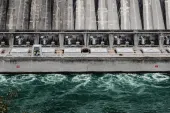
Solar PV: Ultimate goal to reach grid parity
By Anke VerhagenThe long-term outlook for the solar PV industry as a whole looks bright in Rabobank’s view, even though the next couple of years are likely to be turbulent, especially for manufacturing companies.
The growth potential is enormous, as the fundamentals underpinning demand for solar PV power, growing energy demand and increasing energy security concerns and addressing climate change, are not likely to change.
We expect the solar PV value chain to be characterised by a modest level of investments targeted at manufacturing capacity expansion, and a high level of innovation, aimed particularly at further improving cell efficiency and production efficiency along the entire value chain.
All investments are linked to the ultimate goal of reducing the costs of power produced by solar PV in order to reach “grid parity” – price equivalence with conventional power. Grid parity is expected to be reached in an increasing number of countries during this decade, starting in the sunniest countries and in countries with high electricity prices.
As a result, we expect the PV industry to gradually become less dependent on government subsidies, making the sector much more market driven than policy-defined. Asian countries offer good opportunities for growth, as energy demand is increasing, solar resources are good, and in some countries energy security remains a government priority.
For the longer term, Rabobank forecasts global cumulative installed capacity of solar to reach around 148 gigawatts of peak output (GWp) by 2015 and 370 GWp by 2020.
However, following the rapid price developments in wafer-based PV in 2011, the projections for 2020 are subject to change. Growth of the thin-film PV sector is assumed to be mainly determined by the pace at which the sector can expand production capacity and manage to produce at a lower cost per watt than the wafer-based PV competition.
Investment Opportunities
The solar PV industry offers ample opportunity from an asset-investment point of view. Based on Rabobank’s research, the total solar PV energy market (installed capacity) could grow five-fold in the coming decade - up from 67 GW today to well over 300 GWp in 2020.
If a general investment cost of USD 2 to 4 million/MW for a solar PV system is assumed (depending on location, costs of components and installation costs), solar asset financing would need to attract at least about USD 0.6 trillion to USD 1.2 trillion during this period. The actual growth will also be impacted by the scarcity of capital and thus the rising cost of capital plus changes in solar PV support policies in key markets.
In terms of technology investments, solar is still leading Clean Tech sources for venture capital and private equity investment with roughly a quarter of total investments in 2011. Although wafer-based PV is more mature than thin-film PV technology, both still have room for technology improvements.
Rabobank believes that improvements at a system level offer private equity investment opportunities with, for example, better (micro) inverters and power optimisers, where costs are currently high.
Regarding the value chain, the most competitive module makers are based in Asia and this is not likely to change.
However capital equipment for solar manufacturing looks set to remain unattractive in 2012 - we expect the PV module manufacturing market to bottom out this year and investment opportunities should start to reappear in 2013.
On the other hand, stakes in existing generation projects from companies in the solar value chain that are looking to raise cash, may offer attractive returns. Also, the installation and related contracting market is likely to see continued robust sales levels as capacity is rolled out.
Anke Verhagen, Credit Analyst Renewable Energy and Infrastructure Finance, Rabobank International




















 Advertise
Advertise






